Purim begins at sunset on Feb. 25, the 14th day of Adar. The most jubilant holiday in the Jewish calendar, it’s a celebration of good over evil; the defeat of Haman and his heinous plans to exterminate the Jews in Persia. On this wild and nutty holiday, almost anything goes. Good-natured tricks, jokes, costumes, masks, treats—it’s a time to be downright silly.
Back in the olden days (just a year ago), in synagogues all over the world, there were masquerades, drinking, dancing, a festive meal. There was foot-stamping and grogger-spinning. Everyone, adults and kids, dressed up like the classics—Queen Esther, Haman, Mordechai and King Ahasuerus—or really, as anyone they wanted in the backdrop of different party themes everywhere, parading around the room, often with other family entertainment on hand.
Then the coronavirus pandemic struck with its social distancing, restrictions, lockdowns, masking and hand-sanitizing. (Truth be told, it was already here in the United States last Purim to the detriment of many.) Masks take on a whole new meaning. But take heart! Solo, duo or within a “bubble,” we can still enjoy the holiday, albeit at home instead of at synagogue, school or the Jewish community center.
For families, plan a Purim “cook-in.” It’s a good time to entice bored kids into the kitchen. They’ll be thrilled to measure and stir, fill shalach manot for friends and neighbors in sanitary plastic bags (with the promise of getting leftover treats). For the rest of us, many with flexible time on our hands, we can Zoom while we prepare holiday delicacies. The custom dates back to the time of Mordechai, Queen Esther’s uncle. He instructed Jews to celebrate their freedom by “sending portions to one another and as gifts to the poor.”
It’s a good time to entice bored kids into the kitchen.
The most popular Purim treat, hamantaschen, is widely available in supermarkets and bakeries. But the best are homemade, along with your own lekvar, the traditional prune filling. In Yiddish, the three-cornered pastries mean “Haman’s pockets,” as they resemble Haman’s tri-cornered hat, his pockets, even his ears. Sephardic Jews, in fact, deep-fry dough twisted to resemble Haman’s ears. Chimichangas, a Mexican specialty, are tortillas filled with a savory mixture and fried, a close cousin to blintzes. My adaptation is sweet and uses typical Middle Eastern ingredients such as halvah—that sweet sesame-seed paste confection—and cardamom. They may be made ahead of time and frozen; just thaw before frying. For a cookie “you won’t break your teeth on,” Marbleized Mandelbread has only a brief second baking time. The resulting cookie has a cake-like texture. They keep for a week or so in a tightly lidded container or freeze.
But besides the sweet stuff, it’s also the custom to eat peas and bean dishes. The tradition goes that in the court of King Ahasuerus, young Jewish Queen Esther did not want to eat non-kosher foods. She became vegetarian, eating mainly peas and bean dishes. The technique of browning a roux, a mixture of oil or butter and flour, imparts a rich, nutty flavor to Queen Esther’s Gumbo. For my Zoom Purim supper, I’ll spoon the thick bean stew spiked with bold Masala spice over hot, fluffy rice. I keep Masala spice on hand to use in a score of soups, stews and savory dishes like a frittata. An aromatic mixture of cumin, coriander, pepper and cardamom, it packs a mouthwatering punch to soups, stews and savory dishes. (Certified kosher, Masala spice is available online at: www.pereg-gourmet.com.)
Toss a green salad to go with the main meal, and for dessert, dig into Iced Chocolate Grapes and Sweet Chimichangas.
Happy Purim!
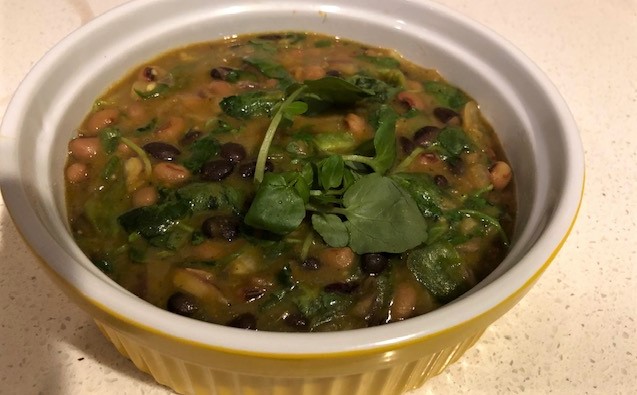
Queen Esther’s Gumbo (Pareve)
Serves 4-6
Cook’s Tips:
*For Masala spice: ½ teaspoon each, cumin, coriander, cardamom and ground black pepper.
*Substitute spinach, collard greens or any other leafy vegetable for watercress.
*Chop onion and bell pepper together in a food processor.
Ingredients:
¼ cup vegetable oil
¼ cup flour
1 medium red onion, chopped coarsely
1 medium green bell pepper, seeded and chopped coarsely
1½ teaspoons bottled minced garlic
2 cups vegetarian broth
1 can (15.5 ounces) kidney beans, drained
1 can (15.5 ounces) black-eyed peas, drained
2 teaspoons Masala spice
2 cups watercress, coarsely shredded
Directions:
Heat the oil in a heavy pot over medium-high heat. Stir in the flour.
Cook, 4-5 minutes, stirring constantly until the mixture turns medium brown. Stir in the onion, bell pepper and garlic.
Cook, stirring, until vegetables begin to soften, about 4-5 minutes.
Add the broth, beans, peas and Masala spice. Stir and reduce heat to low. Simmer 10 minutes. Stir in the watercress.
Spoon over rice to serve.
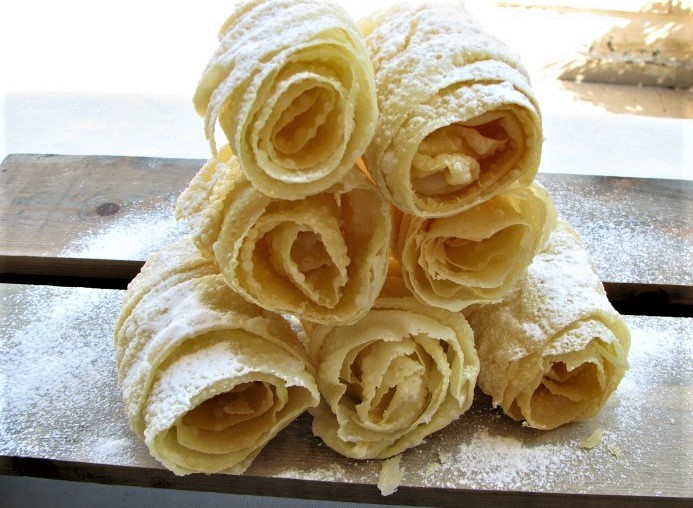
Deep-Fried Haman’s Ears (Pareve)
Makes 12-15
Cook’s Tips:
Substitute 1½ teaspoons vanilla extract for rosewater.
Substitute 1 tablespoon finely grated fresh ginger for powdered ginger.
Ingredients:
1 cup all-purpose flour
¾ teaspoon baking powder
2 tablespoons sugar
1 teaspoon powdered ginger
1 egg, lightly beaten
2 tablespoons vegetable oil
2 teaspoons rosewater
vegetable oil for frying
confectioners’ sugar
Directions:
In a medium bowl, mix the flour, baking powder, sugar and ginger.
Make a well in the center. Pour in the egg, oil and rosewater. Mix well.
Turn onto a floured board and knead until smooth about 1 minute. If too sticky, add a little more flour. Cover and chill for 1 hour. Pinch off small pieces, about the size of a large walnut.
Twist to resemble Haman’s ears. (No need to be perfect; it’s said that Haman’s ears were knobby.)
Heat about ½-inch oil over medium heat. A cube of bread should brown in 50-60 seconds. Add the ears making sure they don’t touch. Fry until puffed and golden on all sides.
Drain on paper towels.
Cool and dredge with confectioners’ sugar.
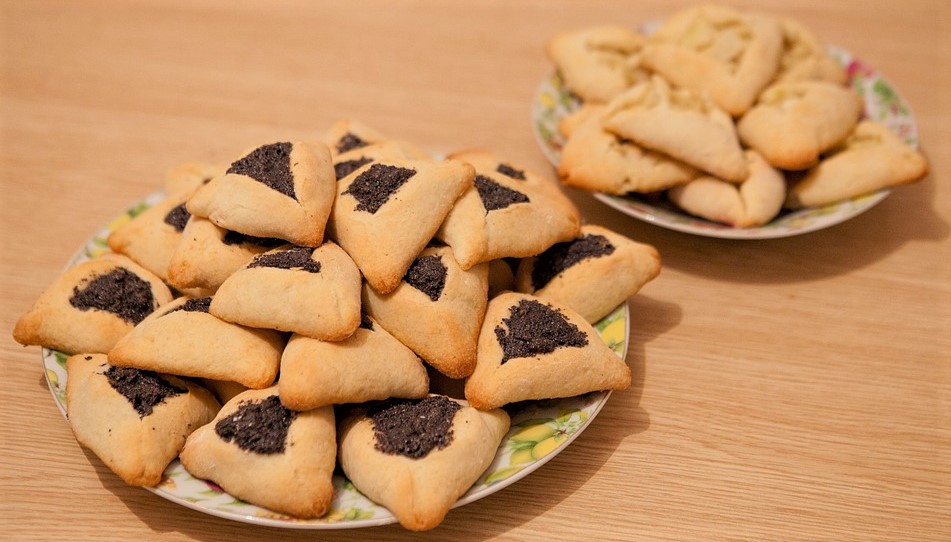
Hasty Hamantaschen (Dairy)
Makes 10
This is a constantly requested recipe for the little triangular pastries from my book, Everyday Cooking for the Jewish Home.
Cook’s Tips:
*Make your own lekvar (easy recipe below).
*May substitute beaten egg for water to dampen.
Ingredients:
½ cup bottled lekvar (prune butter)
1 tablespoon grated lemon zest
½ teaspoon cinnamon
1 package (7.5 ounces) refrigerated biscuits
2 tablespoons honey, warmed
Ingredients:
Preheat oven to 400 degrees.
In a small bowl, mix lekvar, lemon zest and cinnamon. Set aside.
Separate the biscuits. On a lightly floured board, flatten biscuits into a round, about 2½ inches in diameter. Place a teaspoon filling in center of each biscuit.
Dampen edges with water. Fold edges over filling to form a three-sided pyramid, leaving some filling uncovered.
Place about 2 inches apart on a large, ungreased cookie sheet.
Bake in preheated oven 10-12 minutes until golden. Brush with honey and cool.
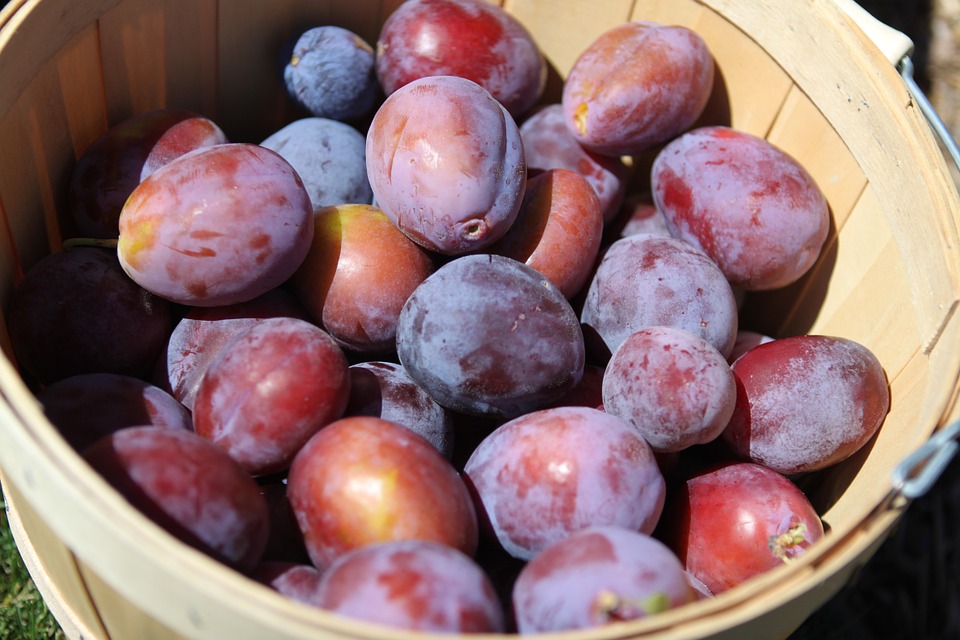
‘Lekvar’: Prune Filling (Pareve)
Makes ¾ to 1 cup
Cook’s Tips:
*For apricot filling, substitute dried apricots for prunes.
*Prepare filling 2-3 days ahead and refrigerate.
Ingredients:
½ cup (10-12) pitted prunes
½ cup orange juice
2 tablespoons lemon juice
1 teaspoon sugar
½ teaspoon cinnamon
Directions:
Place prunes, orange juice and lemon juice in a small saucepan.
Bring to boil over medium heat. Reduce heat to simmer.
Cook until about 3 tablespoons liquid remains. Remove from heat, add the sugar and cinnamon.
Transfer to food processor. Pulse to a coarse paste. Cool completely to use as needed.
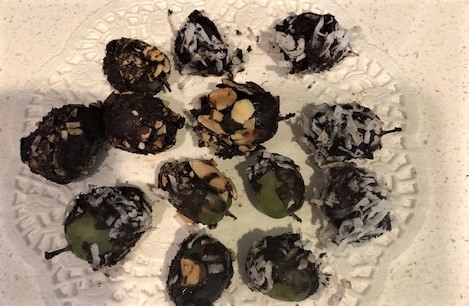
Iced Chocolate Grapes (Dairy)
Makes 6-8 servings
Cook’s Tips:
*Any color grapes may be used.
*Substitute unsweetened shredded coconut for nuts.
Ingredients:
1 ½ to 2 pounds green grapes separated or cut in small bunches
8 ounces dark chocolate, coarsely chopped
1 tablespoon butter
½ cup nuts, finely chopped
Directions:
Rinse grapes and pat dry. Lay out on paper towels to dry well. Set aside.
Line a cookie sheet with wax paper. Place chocolate and butter in a microwave-safe bowl.
Microwave in 25-second bursts to soften.
Stir to a smooth mixture. Dip grapes into chocolate mixture, then into chopped nuts.
Place on prepared cookie sheet.
Freeze 2 hours or overnight before serving.
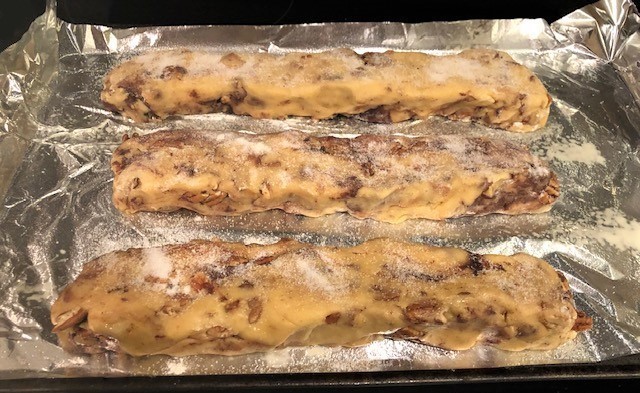
Marbleized Mandelbread (Pareve)
Makes 30-35
Cook’s Tips:
*Add ⅓ cup chopped crystallized ginger.
*Orange and chocolate go well together. Try orange extract instead of almond extract.
Ingredients:
3 eggs
¾ cup vegetable oil
1 cup, plus 1 tablespoon, sugar
2 teaspoons almond extract
1½ teaspoons baking powder
3½ cups all-purpose flour
1 cup chopped walnuts
3 tablespoons chocolate chips, melted
Directions:
Preheat oven to 375 degrees.
Line a large cookie sheet with foil and spray with nonstick baking spray.
In a large bowl, beat eggs, oil, 1 cup sugar and almond extract. Add 1 cup flour along with the baking powder. Mix well.
Add remaining flour, 1 cup at a time, mixing well after each addition.
Stir in the walnuts. Drizzle melted chocolate over the mixture. Cut in with a knife to marbleize.
With lightly floured hands, shape dough into 3 rolls, each about 10 inches long and ¾-inch thick.
Place on prepared cooked sheet. Sprinkle with remaining sugar.
Bake in preheated oven for 20 minutes. Remove from oven and cut each roll into slices about ¾-inch thick. Return to oven and bake 5 minutes longer or until golden-brown.
Cool on a wire rack.
Store in a tightly lidded container or may be frozen.

Sweet Chimichangas (Dairy)
Makes 6
From a dog-eared recipe card; it’s my sweet adaptation of a Mexican specialty.
Cook’s Tips:
*Substitute apricot or other preserves for orange marmalade.
*Chinese Five-spice or nutmeg instead of cardamom.
*Chimichangas may be made ahead and frozen. Thaw before frying.
Ingredients:
3 (8-inch) flour tortillas
¼ cup orange marmalade
4 ounces dark chocolate, crumbled
3 tablespoons halvah, crumbled
powdered cardamom to sprinkle
¼ cup vegetable oil
orange wedges to garnish (optional)
Directions:
Thinly spread each tortilla with orange marmalade to within ½-inch of edges.
Divide crumbled chocolate evenly and sprinkle over the marmalade. Top with crumbled halvah and dust with cardamom.
Roll up as for blintzes: Fold the bottom of the tortilla up over the filling. Fold in left and right sides to encase the filling. Roll up and place seam-side down on a baking sheet. Refrigerate for 30 minutes.
Heat the oil in a large nonstick skillet over medium-high heat.
Place chimichangas, seam-side down, in skillet. Press down lightly.
Fry 2-3 minutes on each side or until golden-brown. Drain on paper towels. Cut in half with a serrated knife.
Place on a serving dish and garnish with orange wedges (optional).
Ethel G. Hofman is a widely syndicated American Jewish food and travel columnist, author and culinary consultant.


























